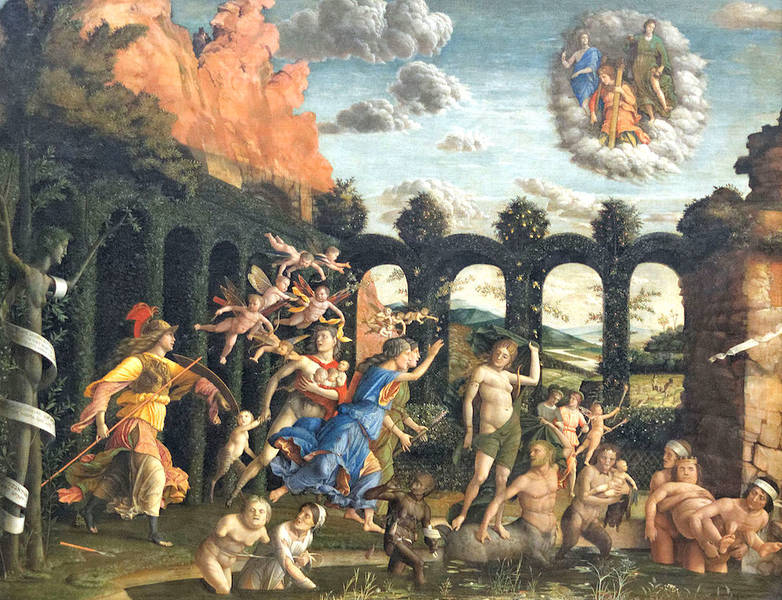‘What Ariosto could see with his eyes shut’ was the intriguing title of a fascinating exhibition held last year in Ferrara. There were long queues outside Palazzo dei Diamanti to see it, a show which was timed to coincide with the 500th anniversary of Ariosto’s publication, at his own expense, of 1,300 copies of his long epic poem Orlando Furioso. The finest copy of this first edition to have survived is held in the British Library.

But who was Ariosto? His poem, which was to have a profound influence on the literature of the Renaissance, was inspired by (and is in many ways a sequel to) Orlando Innamorato by Boiardo, which had been published in Ferrara some 30 years earlier. Both epics deal with literal and moral crossroads forcing a choice between two paths, with wild woods representing labyrinths.
Ludovico Ariosto (1474–1533) was born in Reggio Emilia, to the commander of the castle there, although he always considered himself a Ferrarese. He was a studious boy but his dreams of a scholarly life were brought to an end after the death of his father, when he had to take up a public career. It was then that he entered the service of the Este family, taking up a post under Cardinal Ippolito. Nevertheless, he found time for his studies and for writing, devoting himself to the epic work that was to make his name. In essence it is derived from the courtly romances of the medieval period. The plot turns on the exploits of Charlemagne and his paladin Roland (Orlando) and to set the scene, the curators of the exhibition had chosen art and artefacts representing battles, knights from Arthurian legends and the cult of jousting. Among them were superb drawings and engravings by Ercole de’ Roberti, Antonio del Pollaiolo (his battle of ten nude figures, c. 1465, the first ever signed graphic work, it is now in the Marucelliana library in Florence), Mantegna (three war-like divinities), Marco Zoppo (a lady warrior, lent by the British Museum) and Leonardo da Vinci (a tiny red drawing from the collection of HM the Queen of a stormy encounter between elephants, horses and a giant). Among the artefacts was a perfectly-preserved leather saddle with bone and wood decorations made for Ercole I d’Este (father of Cardinal Ippolito) and a tapestry depicting the legendary battle of Roncesvalles in 778, probably made in Tournai in the late 15th century.
But Ariosto’s work moves well beyond the confines and conventions of courtly medievalism, exploring ideas and themes which were to inform Renaissance inquiry. One of the characters in the epic is the English knight Astolfo, who is conveyed by St John to the moon (described as a metallic sphere) to recover the lost wits of Orlando (Ariosto believed that the only difference between the earth and the moon was the fact that the latter was entirely free of madness). There is a charming little painting by the Ferrarese painter Cosmè Tura illustrating the episode, showing of St John on Patmos sitting with his eagle in a moonscape, apparently waiting for Astolfo. Another artist inspired by the work was Dosso Dossi. In fact his portrait of the sorceress Melissa (now in the Galleria Borghese in Rome) is thought to be the first time a character from Orlando Furioso was chosen as the subject of a painting.
Self-published though he might have been, Ariosto did not lack public admirers. His masters, the Este, were highly cultivated. In 1507 Cardinal Ippolito’s sister Isabella d’Este wrote from Mantua to her brother, mentioning that she had had a very pleasant visit from Ariosto and had heard directly from him that he was at work on the poem. When Ariosto was in Mantua, he would certainly have seen Mantegna’s beautiful Expulsion of the Vices from the Garden of Virtue by Minerva, which was commissioned for Isabella’s private study (it is now in the Louvre). It has a superb sky over a great rocky cliff, which towers above Minerva and creatures symbolising the Vices, each depicted in detail. The work is entirely in the Renaissance spirit, filled with characters from Classical mythology (goddesses, a centaur, satyrs), yet presided over by three of the Cardinal Virtues of Christianity, looking on from within a heavenly cloud.
Alfonso I d’Este (brother of Ippolito and Isabella and husband of Lucrezia Borgia) was Ariosto’s enthusiastic patron and admirer. Just after the poem’s publication, Machiavelli wrote to a friend praising it. Tommaso Inghirami, the noted Churchman and humanist, was a personal friend of Ariosto (he is best known to us from a portrait by Raphael, also a friend of his, uncompromisingly showing his squint, which now hangs in Palazzo Pitti in Florence). Inghirami is named in the last canto of the poem.
Orlando Furioso was a commercial success. On the strength of it, Ariosto was able to build a house for himself in Ferrara (it still stands and can be visited). In fact, successive editions of the poem, revised by the author, continued to appear until 1532, and its fame was such that some three centuries later the romantic epic was recalled by Bryon when he dubbed Walter Scott the ‘Ariosto of the North’.
by Alta Macadam, author of Blue Guide Emilia Romagna.






